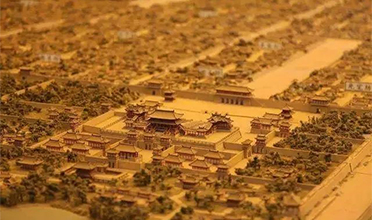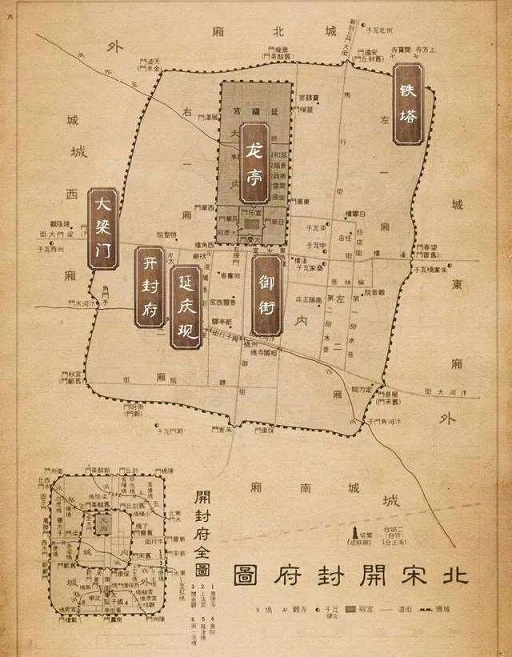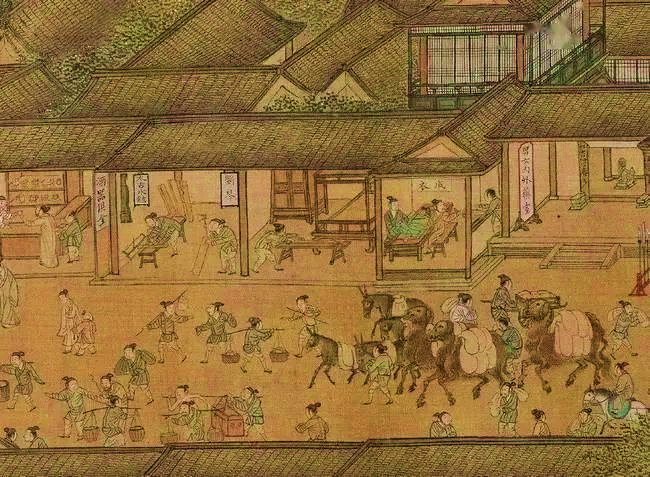


Cities are considered to be formed as the consequences of increasing socio-economic productivity. Given city construction would be affected by political, social, economic, and cultural factors, urban fabric usually presented the characteristics of different periods. With the development of handicrafts and the booming demands for trading business, ancient cities gradually appeared in China at the twilight of primitive society. By the early stage of the feudal society, Li Fang (里坊), an enclosed urban form, was typical in Chinese ancient cities when the political ambitions of urban construction outweighed the productivity. Later, a more open urban form- Jie Xiang (街巷) gradually replaced the old fabric with the prosperity of business activities. The City of Chang'an (长安) in the Sui and Tang dynasties (A.D. 581-907) and the City of Kaifeng (开封) in the North Song dynasty (A.D. 960-1127)- are representative examples of these two different urban forms.
1. Li Fang: regular and enclosed urban blocks
Li Fang (里坊) was the basic unit of residential areas in ancient China, which was also named Li (里), Lv (闾) or Lv Li (闾里) in the period prior to the Qin dynasty (B.C. 221-206). Referring to cultivated fields initially, the Chinese character-Li (里) was used to name urban settlements after the emergence of cities. The extended meaning of Li, in fact, was a continuity of the agricultural land division. Lis were usually walled square or rectangular urban blocks with gates. Fang (坊) dates back to the Northern Wei (A.D. 386-534), and it later referred to residential areas within city walls in the Sui and Tang dynasties (A.D. 581-907).
1.1.The grid pattern of the City of Chang'an
Forming before the 3rd century B.C., Li Fang had developed in the following centuries, and it matured in the Tang dynasty when the capital city-Chang'an was a model of Li Fang. The distinctive feature of Chang'an City was its grid plan which was surrounded by several layers of city walls, the whole city consisted of an outer wall, a palace city and an imperial city.
The palace city was located in the northern part of Chang'an adjacent to the imperial city which was in the middle of the City. The rest part of Chang'an was arranged according to a grid plan and an axis starting from the main gate of the imperial city divided the urban area into two equal parts. Most of those blocks were walled residential areas-Fang (坊), meanwhile, some blocks were used for public functions and market areas.
Due to the residential segregation of different occupations, residents were allocated in different Fangs. The areas near markets were most populated, Fangs surrounding the East Market were mostly occupied by elites, while many businessmen concentrated in the West Market.

1.2.The management of the City of Chang'an
With the form of Li Fang, curfews were carried out by closing the gates of the City and Fangs. Residents should stay within their blocks, and the public areas and streets were not accessible until the next morning.
The functions of residences and markets were also taken apart. Dwellers were not allowed to have their stores in Fangs, they should approach markets if they hoped to shop. Market blocks were also enclosures. In the markets, the stores were arranged and allocated according to the categories of goods, and the prices of the goods were under the management of the government.
Li Fang applied grid plans for zoning, meanwhile, this urban form was an effective tool for the management of ancient cities.

2. From Li Fang to Jie Xiang
With the rapid boom of trading and handicraft manufacturing, more spaces were demanded for business activities in cities, and the enclosed urban form no longer met the requirement. The rules of construction, zoning and curfews in Li Fang had been challenged since the middle of the Tang dynasty. In the North Song dynasty (A.D. 960-1127), curfews were abolished, and the walls of Li Fangs were demolished for the soaring urban activities. Since then, a new urban form-Jie Xiang (街巷) took over the role of Li Fang and characterised the City of Kaifeng. The transformation of urban forms broke the temporal and spatial boundaries of urban life, which created novel landscapes and opportunities in cities.

There were four royal roads across the City of Kaifeng, which were the frame of the urban plan. Instead of the boundaries of Li Fang, architectural gateways-Paifangs (牌坊) became the marks of different urban spaces. The increasing mobility and accessibility of Jie Xiang greatly promoted the social and economic activities in the City. In the light of urban regeneration and the dense population, many central administrative institutions were allocated in areas out of the imperial city, which broke the urban segregation with regard to occupations.
Business trading benefitted from the open form of Jie Xiang, stores were freely opened in the City of Kaifeng. Due to the abolishment of curfews, markets could be run overnight without regard to weather.

Source: <https://mp.weixin.qq.com/s/BjpvhRX5tkL7yaCEYvoaqA>
Edited and translated by Liang Xiuchun